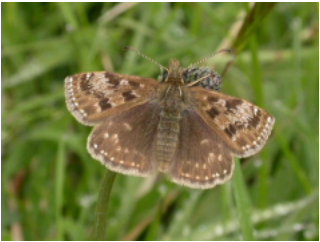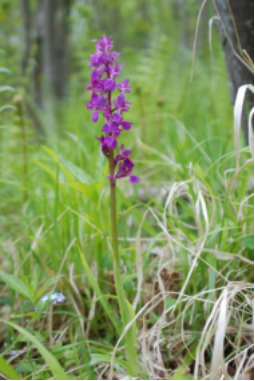Next Topic
Select SDGs to find out how we are taking action in support of the UN Substinable Development Goals
2023 ISRAEL CHEMICALS LTD. | ALL RIGHTS RESERVED

For over a decade ICL Boulby has worked with the Industry Nature Conservation Association (INCA) in monitoring and managing the wildlife which lives in close proximity to the mine. Key to this process is the Site Biodiversity Action Plan (Site BAP) operated by ICL Boulby within its operational area. The site BAP is designed to conserve the key habitats and species which live at the site, and is assisted by INCA annually.
2021 was an unusual time for weather in the North Yorkshire Moors. With periods of cold, dry weather dominating much of the late autumn to late winter periods. Despite unfavourable weather and the continued challenges that the Covid-19 pandemic present, ICL along with INCA have made substantial progress on the biodiversity action plan. A summary of activities undertaken:
In addition, and outside of the immediate scope of the Site BAP, INCA also gave further advice to ICL Boulby staff in relation to ecological considerations associated with one area of subsidence in Mines Wood and remedial repair work required on a bridge near to a local town.
Butterflies and moths are highly sensitive to changes in their environment, including weather. In 2021, the spring through April and May was often dry but cold, which undoubtedly delayed the emergence of some of those species which fly earlier in the year. Moth surveys of the site in recent years have mostly been in summer so the opportunity was taken in 2021 to survey those moths which fly in Ridge Lane Wood in the early spring season, on 19 April. In addition to a number of commoner species this survey yielded two regionally significant new species for the site, the Pale Pinion Lithophane socia and the White-marked Cerastis leucographa. Both are woodland species and in Ridge Lane Wood are most likely to be associated as larvae with the Goat Willows Salix caprea that grow along the access track which leads through the wood.

The onset of fairly stable, sunny, and warmer weather in late May proved to be a real bonus for one of the site’s key species, Dingy Skipper Erynnis tages, which had a good year. Seven reasonably fresh butterflies were seen within the Mines Wood grasslands on 9th June. The emergence is later than the Tees estuary populations, which had already passed their peak by this date and is slightly later than the emergence at Mines Wood in mid-May in 2020, probably due to the colder spring in 2021. Few other butterfly species were noted during the visit, but numbers of Common Blue remain strong, with 17 butterflies having been seen in the same area.

Small Pearl-bordered Fritillary Boloria selene was discovered as being resident in the grassland area of Mines Wood on 24 June 2016. It was an exciting development for the Site BAP as this new colonist to the site is a UK BAP Priority Species and has undergone a severe decline in England. Unfortunately, it was subsequently found that spoil had been deposited during the winter of 2016-7 on the very area where the butterfly had been found. This was during archaeological excavations of an adjacent site. The butterfly overwinters as a small caterpillar, feeding on Common Dog-violet Viola riviniana and other violet species which grow in the area affected.
Surveys were undertaken in suitable weather in the emergence period of the butterfly (mid-June to mid-July) in 2017 to 2019 inclusive to ascertain if the species had survived, but these were to no avail.
Although the spoil deposition had almost certainly destroyed the initial breeding area, investigation has shown that violets occur across the grasslands within the site. It should therefore be possible to re-introduce the butterfly to suitable areas of the site so that it may become firmly established outside of its main breeding areas in our region, which are on the North York Moors (the nearest known breeding colony is at Scaling Dam). With staff at ICL Boulby supportive of this concept, an initial recce of the site was undertaken in June 2021 and accompanied by Dave Wainwright, Senior Regional Manager for Northern England of the charity, Butterfly Conservation. He agreed with the feasibility of such a project and would work with INCA and ICL Boulby to that effect. A key target for 2022 will therefore be to take necessary steps to realise the project.
Following the UK’s exit from the EU, the UK Government committed to maintain its focus on environmental protection in its various forms. This led ultimately to the Environment Act, which passed into UK law on 9 November 2021. This Act covers a range of themes which include halting species decline and enhancing our natural environment.
Central to the aim of enhancing our natural environment is the concept of Biodiversity Net Gain (BNG). This relates to planned development activity, such as plant construction or deconstruction, and requires that any such development achieves ten per cent uplift in biodiversity value compared to the pre-development situation, using a calculated metric to measure this objectively. This process therefore involves identification of habitat creation/enhancement projects which satisfy the BNG needs for development of a site. Discussions have taken place during 2021 to educate ICL about this new process and how it might link with the Site Biodiversity Action Plan (BAP) and INCA undertook some initial investigations of largely agricultural land around the site in the Spring of 2021 in this respect.
The concept of BNG will undoubtedly help to reverse biodiversity loss locally but one drawback of the process is that it applies only to habitats and not to individual species. Whilst enhanced habitats will undoubtedly benefit some species, other species have more specialised requirements which might not necessarily be met, so it is important to recognise that the Site BAP remains an important mechanism to highlight the importance of key species on the site and to target measures to retain the habitats that support them in good condition. Indeed, the Site BAP continues to show benefits for a variety of specialised flora and fauna irrespective of the formal Net Gain process, ranging from butterflies, to orchids, to nesting birds and important grassland mammals such as Brown Hare. The plan therefore remains an important facet in demonstrating ICL Boulby’s commitment to the environment as well as contributing significantly to the recovery of biodiversity in our sub-region.

Advice was given through the 2021 season in relation to grassland management, including in relation to the removal of encroaching scrub vegetation in the Mines Wood grasslands. The main issues relate to Bramble, Dog Rose and Hawthorn. Having identified the plants requiring removal, the physical work to cut and compost the encroaching scrub was then undertaken by ICL Boulby. Such work will maintain these grasslands in good condition, not least for many of the important invertebrate species such as bees and butterflies that use them. The degree of encroachment will be monitored by INCA and ICL.
It was not possible to carry out the usual wintering bat survey of the disused mineral line tunnel in 2021 due to guidance from the Bat Conservation Trust that hibernation roost surveys should not take place. These guidelines, however, have relaxed for the 2022 season so it will be possible to reinstate this survey with the simple precaution of wearing a face mask to minimise the potential risk of bat-human cross-infection.
Historical discharge of insoluble mining waste (mine tailings) from the ICL (UK) Boulby Mine led to the localized accumulation of some insoluble material in the sediments of the Boulby sand patch. Ecological surveys have been performed annually by ICL Boulby in order to assess the extent of accumulation of this material and to monitor its environmental impact, including the impact of any compensatory dredging activity. Annual ecological monitoring surveys have been conducted since 1970, enabling comparison of historical data and the determination of long-term trends. Annual monitoring results are reviewed by the Boulby Mine Working Group (BMWG) comprising representatives from ICL, Ramboll, survey team, local authorities and the Environment Agency.
The overall ecological impact at Boulby is substantially less than in 1990.
The 2019 Benthic Survey showed a reduction in overall species diversity compared to 2018. However, this species reduction was found not only at the tailings outfall, but also the local reference stations, indicating that wider environmental factors may be influencing these changes.
The Boulby Mine working group categorizes sample stations as impacted, intermediate (A) and (B) and sparse, offshore background. This rating system showed an overall lower impact based on their criteria in 2019. In terms of severity, the overall ecological impact at Boulby is substantially less than in 1990.
The Boulby Mine discharge continues to influence the sediment physico-chemical composition at stations within the Boulby sand patch, which is reflected in the benthic macrofauna communities. However, compared with 2017 a decrease in the silt-clay fraction was recorded, determining a change in the benthic fauna composition towards species found in coarser sediments. The influence is mainly from sediment physico-chemical parameters, such as particle size rather than direct toxicity, since metal contaminant concentrations in sediment are generally below TEL threshold values indicative of no or low biological effect.
As production has shifted from potash to polyhalite, there is now less discharge into the North Sea.
The quantity discharged in 2018-9, is almost halved compared with 2017. As production in ICL Boulby has now completely shifted from potash to polyhalite, there will be less discharge into the North Sea. The quantity discharged in 2018-9, is almost halved compared with 2017. As production in ICL Boulby has now completely shifted from potash to polyhalite, there will be less discharge into the North Sea.

